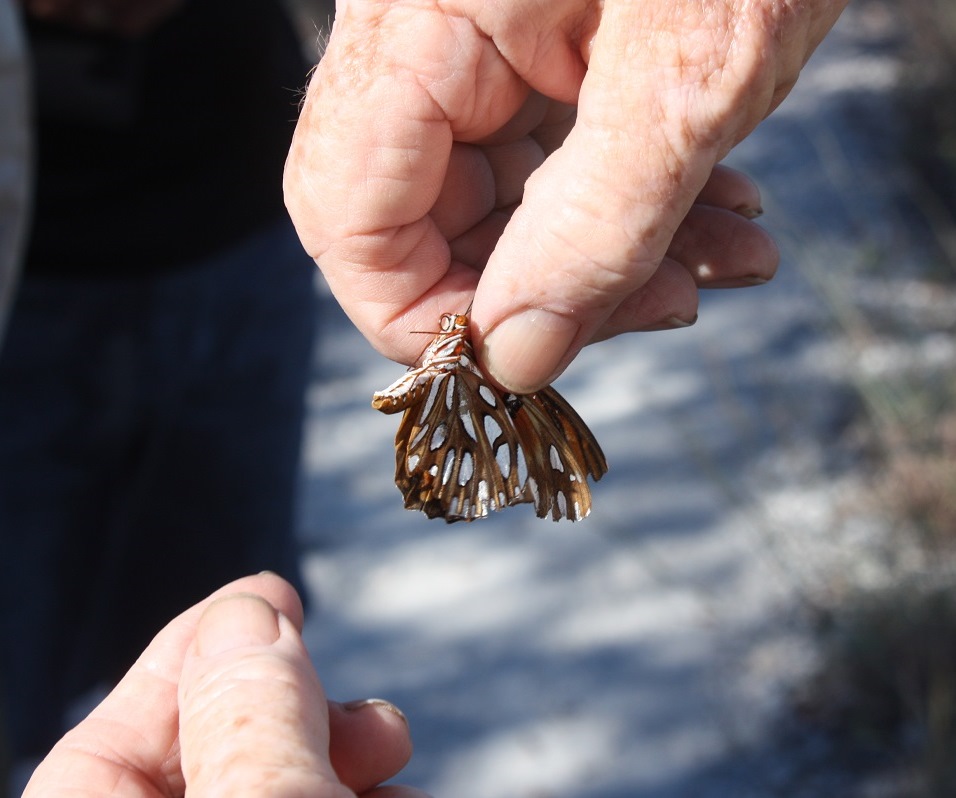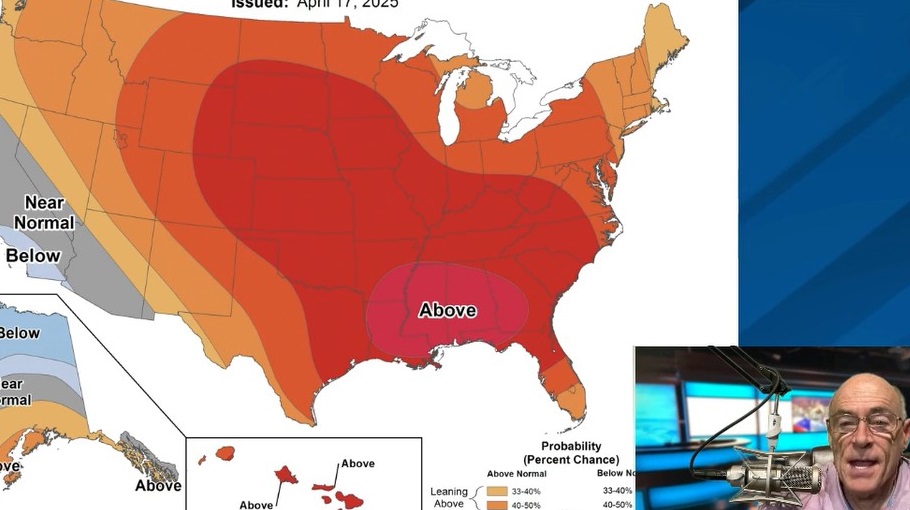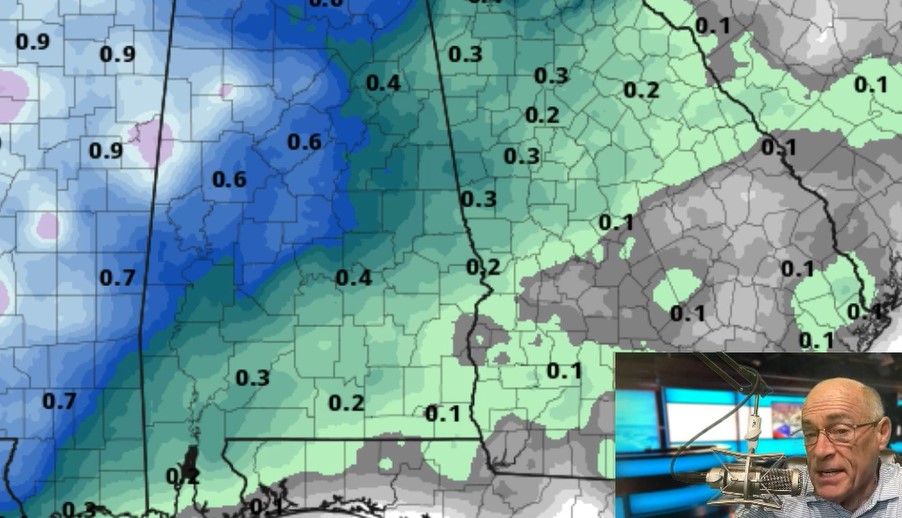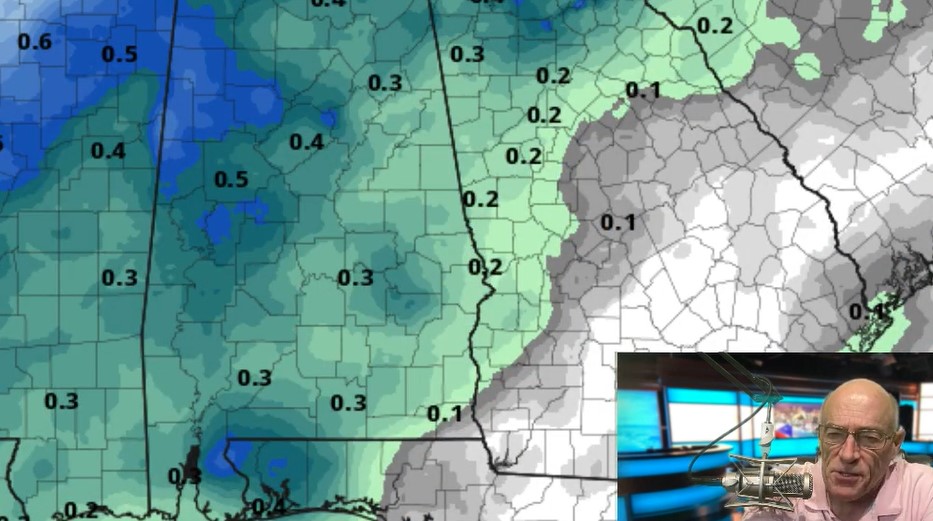Butterflies at the beach: Alabama’s Gulf Coast in the fall is aflutter with colorful insects

Even before the monarchs arrive, other species make the Alabama Gulf Coast a great place for butterfly watching. (Robert DeWitt/Alabama NewsCenter)
Homer Singleton flicked his wrist quickly and his net landed deftly on top of his quarry. It was his third attempt at capturing a butterfly on this morning, and he finally succeeded despite the roaring north winds that made capture difficult.
While his net covered the butterfly, Singleton’s job was not done. The goal was to remove the delicate creature without harming it. Slowly and carefully he trapped the insect in the netting and then reached inside. As he held it in his hand, a crowd gathered around.
Singleton led a group of 12 out onto the Bon Secour National Wildlife Refuge’s Gator Lake Trail on a windy Friday morning in hope of finding monarch butterflies. But they hadn’t quite arrived. This was a Gulf fritillary, a species that looks much like the monarch and has been migrating through the area in large numbers.
“I’m going to let him go now,” Singleton said. “Everybody ready?”
He opened his hand. The Gulf fritillary fluttered away as if nothing had happened.
Butterflies bring an extra splash of beauty to Alabama beaches from Alabama NewsCenter on Vimeo.
From Canada to Mexico
Butterflies glide along on wings as thin as paper, seeming not so much to fly as to be blown indiscriminately by the slightest breeze. But don’t be deceived. Butterflies are moving with a purpose and they definitely have a destination in mind.
During the fall, a number of butterfly species, including the colorful monarch, are on the move through Alabama, and there are few better places to observe them than the Alabama Gulf Coast. Brittany Petersen, assistant refuge manager for the Bon Secour National Wildlife Refuge, said monarch butterflies migrate all the way from Canada down the East Coast to the Gulf of Mexico, and then turn west on their way to Mexico, where they winter.
“Being in the coastal area does tend to concentrate them,” said Petersen. “Monarchs migrate from all over the U.S. and from Canada. There are patchworks of habitat that are important, and along the coast is one of them.”
The Bon Secour National Wildlife Refuge offers people an opportunity to take advantage of the seasonal butterfly bounty with its Monarch Walks, which began Oct. 19. Twice a week, Singleton, a refuge volunteer, takes groups on a 2-mile walk through the refuge, just west of Gulf Shores, in search of monarchs and other colorful species like common buckeye, Gulf fritillary, painted lady and viceroy.
“As they come south and hit the Gulf, they turn and go along the coast,” Singleton said. “They don’t try to go the 600 miles across the Gulf of Mexico.”
On cloudless, breezy days that are typical on the Gulf Coast during the fall, orange and black splotches can be seen flitting across the clear blue sky in singles and pairs. It starts in September with the Gulf fritillaries and the buckeyes. The viceroys follow later in smaller numbers and then come the monarchs, prized for their dazzling color patterns.
On this day, the monarchs hadn’t yet appeared. But there was still plenty to see. Singleton explained to the group the monarch lifespan and its epic journey from Canada to Mexico. Along the trail he pointed out plants important to butterflies, and the group observed buckeyes and Gulf fritillaries.
“This was something new for me,” said Ann Scott of Racine, Wisconsin. “I enjoyed learning how they tagged them and about the different types. It was a learning experience.”
Her friend, Cathy Bell of Gulf Shores, was disappointed not to see any monarchs. But as a nature lover, she enjoyed learning about the other species.
“I see a lot of these in my backyard,” she said. “Now I know the difference.”
Singleton has led numerous Monarch Walks and still enjoys the experience.
“It seems like every time you go out, you see something that is unique to that day,” he said.
Scaring away the birds
The Gulf fritillaries and the viceroys are known as “mimics” because they closely resemble the monarch. Looking like a monarch has its advantages. The monarchs feed on milkweed, which contains a toxin. That makes the monarchs toxic to birds. The birds know it and leave the monarchs alone.
The Monarch Walks are along the refuge’s Gator Lake Trail because butterflies tend to concentrate in the open area of the forested refuge. The emphasis is on monarchs because they are the most “dramatic,” sometimes collecting in large numbers to roost on trees and shrubs, Singleton said.
“Nature is fickle,” Petersen said. “Hopefully, we’ll have some monarchs in the area.”
Walk participants observe and participate in capturing and tagging butterflies. Tagging is accomplished by placing a small sticker on the butterfly’s wings that biologists can spot while observing them at locations along the way.
“The whole idea is to see where these butterflies are coming from and where they are going,” Petersen said.
Reversing the decline
Monarch numbers are declining, and understanding their habits will allow scientists and wildlife managers to understand how they can reverse that decline.

Homer Singleton demonstrates how those who study butterflies carefully catch them without harming them. (Robert DeWitt/Alabama NewsCenter)
Scientists believe habitat loss is chief among the multiple reasons for the decline. Urbanization and large-scale farming and logging operations in Mexico have claimed natural habitat that is useful for butterflies.
The Bon Secour refuge provides thousands of acres of natural habitat. But habitat doesn’t have to come in large tracts to benefit butterflies.
“Any natural part of Alabama that is left is important,” Petersen said. “All they need is that patchwork of habitat, so it can be created in your backyard.”
Observing butterflies in his backyard near Wolf Bay is what got Singleton, a lawyer by trade, interested in knowing more about them.
“I had butterflies in my yard and I watched them and was curious about them,” Singleton said. “That was increased a lot when I realized there were problems with butterflies and other pollinators.”
Three generations
The monarch’s story is interesting. One generation born in Canada and the northern U.S. lives for six months and travels to Mexico in winter, where it can maintain a constant body temperature necessary for survival. There it lays its eggs and dies.
“They have a phenomenon where their metabolism basically shuts down, called a state of diapause,” Singleton said.
But the trip back north takes three generations of butterflies.
“They’ll eventually fly back, but it takes several generations to get back to the northern summering grounds,” Petersen said. “It’s one of those strange things in nature.”
The generation that hatches in Mexico migrates to northern Mexico or southern Texas before laying eggs and dying. The next generation makes it to the Midwest before laying eggs and dying.
The generation that hatches in the Midwest goes to Canada and spends the summer before laying its eggs and dying. The generation that hatches in Canada migrates to Mexico and makes up the butterflies that travel along the Alabama Gulf Coast.
“They really are amazing,” Singleton said.










